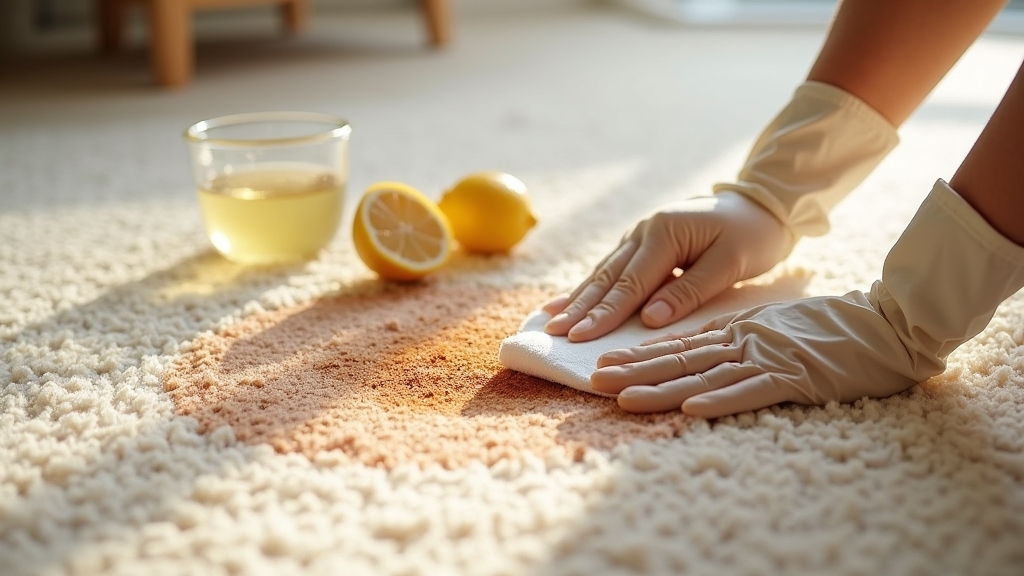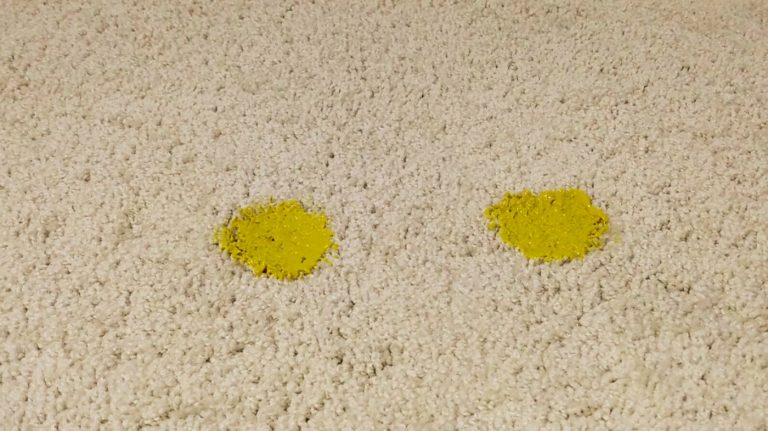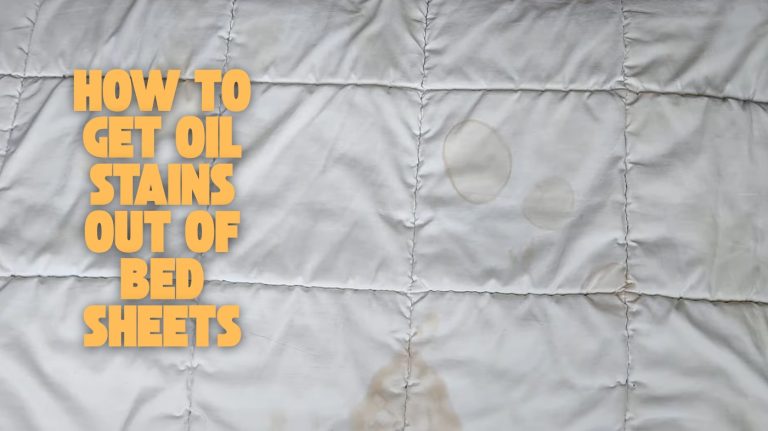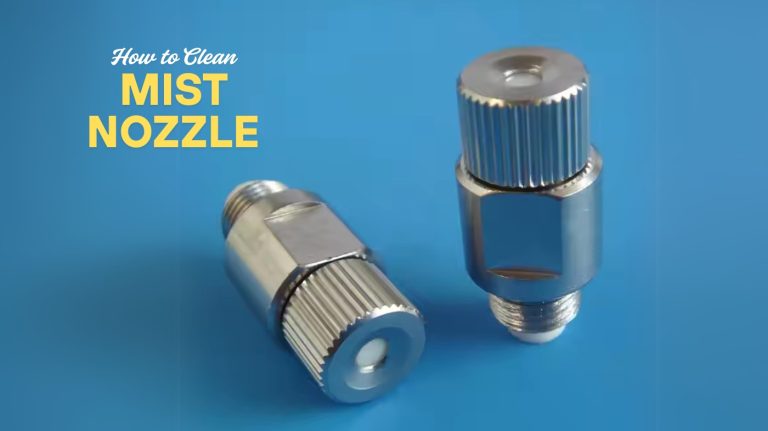How to Get Rid of Rust Stains on Carpet? Fast and Easy Guide
To get rid of rust stains on your carpet, start by vacuuming the area to clear debris. Then, apply a homemade paste made from white vinegar and salt or lemon juice and salt for light fabrics, letting it dry before gently scraping.
For tougher stains, use a carpet-safe commercial rust remover, following safety precautions and testing first. Blot with a clean cloth and rinse lightly.
Thorough drying and vacuuming finish the process, ensuring no residue remains. Understanding these steps helps tackle even stubborn rust effectively.
Key Takeaways
- Act quickly to prevent rust stains from setting and vacuum the area to remove loose dirt before treatment.
- Apply a vinegar and salt paste or lemon juice with salt for natural rust removal, testing on a hidden carpet spot first.
- Use commercial rust removers labeled safe for carpets, following instructions and wearing protective gear for safety.
- Gently agitate the stain with a soft brush and blot with a clean cloth, avoiding vigorous scrubbing to protect fibers.
- Rinse thoroughly with cold water, blot excess moisture, allow the carpet to dry fully, then vacuum to restore texture.
Understanding Rust Stains on Carpet
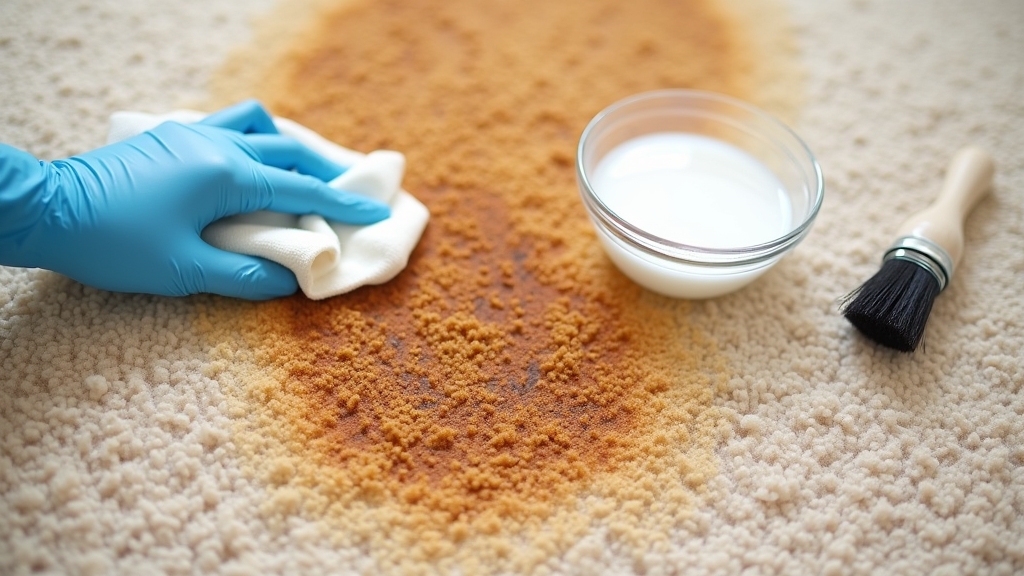
Although rust stains on carpets may seem like a minor nuisance, they result from a complex chemical reaction called oxidation, where iron or steel reacts with moisture to form iron oxide.
This reddish-brown residue attaches firmly to carpet fibers, making removal difficult. Rust formation is primarily caused by iron exposure to moisture or water, which initiates the oxidation reaction.
Rust often originates from metal objects like steel furniture, nails, or lamps left in damp conditions. Environmental factors such as humidity and spills accelerate corrosion, increasing stain severity.
Understanding the chemical interactions involved is similar to the awareness needed when choosing appropriate cleaners for different surfaces, such as the importance of chemical compatibility in cleaning products.
Physically, rust stains appear as orange or dark brown spots, sometimes with powdery flakes or ring-like patterns reflecting the metal’s shape. Over time, the iron oxide penetrates deeper into fibers, causing permanent discoloration and weakening the carpet’s structure.
Preparing Your Carpet for Rust Removal
Before you tackle rust stains on your carpet, start by thoroughly evaluating the affected area and gathering all necessary tools. Identify the stain’s location, check its size, and remove nearby objects to prevent contamination.
Assess your carpet fiber type since treatments vary for nylon, polyester, or wool. This step is crucial to avoid damaging the carpet during the cleaning process.
Then, vacuum the area to remove loose dirt and debris. Prepare your cleaning supplies, including cloths, a soft brush, and mild cleaning solutions. Always pretest cleaners on a hidden spot to ensure they do not cause discoloration or damage.
| Step | Action |
|---|---|
| Area Assessment | Locate stain, check rust source |
| Fiber Check | Identify carpet material type |
| Cleaning Tools Ready | Vacuum, cloths, brush, solutions |
| Pre-Clean Steps | Vacuum, blot stain gently, avoid rubbing |
| Safety Measures | Pretest cleaner, wear gloves |
Homemade Remedies for Rust Stain Removal
You can create an effective rust stain remover using a simple paste of white vinegar and salt. This mixture works by dissolving rust while gently abrading the fibers.
It is important to test cleaning solutions on a small, inconspicuous area of the carpet first to avoid any potential damage. Using non-toxic, eco-friendly cleaners helps ensure safety for your family and pets during the cleaning process.
Alternatively, applying lemon juice combined with salt offers a natural bleaching effect. This method is especially effective when followed by sunlight exposure.
After treatment, allow the mixture to dry completely. Once dry, carefully scrape off the residue. Finally, vacuum the area to guarantee thorough cleanup.
Vinegar and Salt Paste
When tackling rust stains on your carpet, using a vinegar and salt paste offers an effective homemade solution that combines chemical and mechanical action. Mix about 1/4 cup of table salt with enough white distilled vinegar to form a thick paste that clings to the stain.
Apply it directly onto the rust spot and let it dry for 5 to 10 minutes, or longer for tougher stains. It is important to avoid acidic treatments on sensitive surfaces like marble, as vinegar’s acidity can cause surface etching. Gently agitate with a soft brush to help the acidic vinegar dissolve rust oxides while salt abrasively breaks them down.
Once dry, carefully scrape off the residue and vacuum thoroughly. Repeat as needed for persistent stains.
Test on a hidden area first, avoid over-saturating, and ventilate well to manage vinegar odor during treatment. It is important to allow the carpet to dry completely between applications for best results.
Lemon Juice Application
Building on the effectiveness of vinegar and salt paste, lemon juice offers another natural acid-based approach for removing rust stains from carpets. Its citric acid reacts with iron oxide, dissolving rust and loosening it from fibers.
To apply, saturate the stain with fresh or bottled lemon juice, optionally mixing in salt for mild abrasion. Let it sit for at least 30 minutes, extending to a few hours for stubborn stains; sunlight can speed this reaction.
Blot gently afterward to avoid fiber damage. Lemon juice’s mild bleaching effect suits light-colored carpets but test first to prevent discoloration.
Repeat applications may be necessary for deep-set rust. This method provides an eco-friendly, non-toxic alternative, though it may not fully eliminate severe rust without persistence.
For best results, always conduct a preliminary test on a small, hidden area to check for any adverse effects, similar to testing cleaning solutions on brass.
Drying and Cleanup Steps
Although treating rust stains with homemade remedies is effective, thorough drying and cleanup steps are essential to prevent further damage or staining.
Immediately blot excess moisture with a clean, dry cloth to avoid spreading the rust. Using personal protective equipment during cleaning can also protect your skin and eyes.
Allow the carpet to air dry completely; use a fan or hairdryer on low heat to speed drying without harming fibers. Prompt removal helps prevent the rust stain from setting deeper into the carpet fibers.
After drying, vacuum the area to lift fibers and remove residue. If you’ve applied a vinegar and salt paste, let it dry fully before gently scraping or vacuuming it off.
Rinse lightly with water using a damp cloth to remove cleaning agents, but avoid over-wetting. Finally, repeat drying and vacuuming cycles as needed to restore the carpet’s texture and ensure complete rust removal.
Using Commercial Rust Removal Products
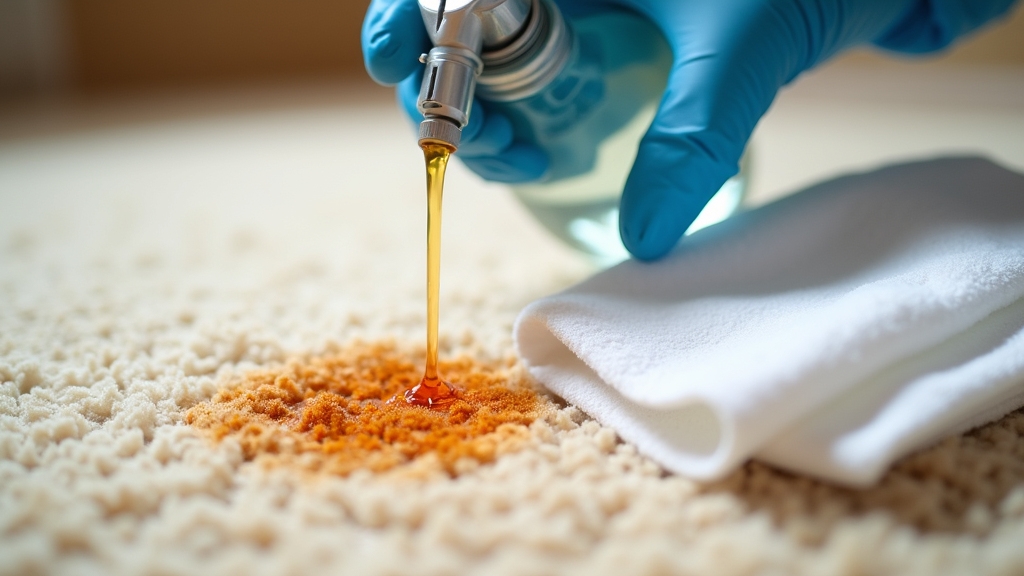
When choosing a commercial rust remover, select one compatible with your carpet’s fiber and color. Always test it on a hidden spot first to ensure it doesn’t cause damage or discoloration. Apply the product as directed—usually with a cotton swab or spray.
Many effective rust removers are acidic products that work quickly and prevent re-soiling or browning. Using tools with ergonomic handles can improve precision and control when applying the remover.
Allow it to sit briefly before rinsing and blotting thoroughly. Remember to wear protective gloves and work in a well-ventilated area. Follow safety instructions carefully to avoid damage or injury.
Product Selection Tips
Since rust stains vary in severity and carpet types differ widely, selecting the right commercial rust remover requires careful consideration of product safety, chemical composition, and compatibility with your specific carpet fibers.
Choose products clearly labeled safe for carpets and upholstery to prevent fiber damage. Consider acid-based removers for faster action but handle them cautiously, or opt for chelating agents that are gentler and sometimes nontoxic.
Some removers, like Whink Rust Stain Remover, are specifically formulated to work effectively on both hard surfaces and soft fabrics such as carpets and clothing, providing quick stain removal with minimal damage to fibers rust remover for clothing.
Match the remover to your carpet’s color and material; test on an inconspicuous spot first. It is also important to vacuum thoroughly before application to remove any loose debris that could interfere with stain removal.
For small stains, liquid removers with narrow applicators provide precision, while tougher stains may need industrial-strength formulas.
Application Instructions
After you’ve chosen the right rust remover for your carpet, applying it correctly guarantees the best results without damaging fibers. Start by testing the product on a hidden spot to rule out discoloration.
Then, follow these steps for effective stain removal:
1. Saturate the rust stain with the remover, using the recommended application method (spray, pour, or swab), and let it sit as per instructions. The Rust Rid Rust Stain Remover is colorless and odorless, making it suitable for use without adding unwanted scents. Ensure you keep flammable materials away during this process as a fire safety precaution.
Lightly agitate with a soft brush if needed.
2. Gently blot the area with a damp cloth to lift the dissolved rust; avoid vigorous scrubbing to protect carpet fibers.
Repeat if necessary, but don’t oversaturate.
3. Rinse thoroughly with cold water to remove residues, then blot dry.
Allow the carpet to air dry completely before evaluating results or reapplying.
Safety Precautions
Although rust removers effectively eliminate stains, you must prioritize safety to protect yourself and your surroundings. Always wear chemical-resistant gloves, safety goggles, and protective clothing to prevent skin and eye contact.
Use masks or respirators in poorly ventilated areas. Ensure good airflow by opening windows or using fans, and avoid confined spaces. Working in a well-ventilated environment helps disperse hazardous fumes and dust. It is also important to wear protective gear to guard against exposure to harmful substances.
Select products labeled safe for carpets, follow instructions precisely, and never dilute unless specified.
Store chemicals securely, away from children and pets. After application, ventilate thoroughly and consider vacuuming to reduce residue. Keep running water nearby to flush accidental exposures immediately.
Mechanical Techniques to Enhance Cleaning
When tackling rust stains on carpet, mechanical techniques play an essential role in enhancing the effectiveness of cleaning agents. You’ll want to prepare the surface carefully and agitate it gently to loosen rust particles without harming fibers.
Here are three key techniques:
Discover three essential mechanical methods to effectively tackle rust stains on your carpet.
- Vacuum thoroughly to remove debris and lift fibers. Then use a soft brush in varying directions for light agitation.
- Apply steam via a damp towel and a steam iron for 30 to 60 seconds to loosen embedded rust. Always protect fibers with a cloth barrier. Dwell time is critical for rust removers to work effectively.
- Blot gently with clean, white cloths to lift rust residues. Rinse thoroughly, changing cloth sides frequently to avoid redepositing stains.
Combining Ingredients for Tough Rust Stains
Since rust stains can be particularly stubborn, combining specific ingredients enhances your cleaning efforts by targeting rust chemically and physically.
Start by mixing white vinegar with salt to form a paste; vinegar’s acetic acid dissolves rust while salt provides mild abrasion. Apply the paste directly, let it dry fully, then scrape off residue. Before applying any paste, it is important to remove floor mats to access all affected carpet areas.
For light-colored carpets, a lemon juice and salt paste works similarly, with sunlight boosting its bleaching action—avoid this on dark fabrics.
Alternatively, blend vinegar and baking soda into a paste; after 30 minutes, gently scrub with a soft brush and rinse.
For added power, you can spray a natural stain remover post-paste application, followed by diluted carpet shampoo. Always rinse thoroughly and vacuum once dry to lift loosened rust particles effectively.
Safety Tips and Precautions During Treatment
Because rust removal involves chemicals that can irritate skin, eyes, and respiratory systems, you should always wear appropriate personal protective equipment (PPE). This includes rubber gloves, safety goggles, and a mask if fumes are strong.
Work in a well-ventilated area to minimize inhalation risks. Also, keep children and pets away until the carpet is fully dry. Using acid-based rust removers requires proper rinsing and neutralization after use to prevent damage.
Follow these essential safety tips:
- Test rust removers on a hidden carpet spot before full application to avoid damage or discoloration.
- Never mix chemicals unless specified; hazardous reactions may occur.
- Rinse treated areas thoroughly with cold water and neutralize acid-based products to prevent fiber damage.
Step-by-Step Guide to Effective Rust Stain Removal
Before tackling rust stains on your carpet, start by preparing the area properly to guarantee the most effective treatment. Vacuum the stain to remove debris and identify your carpet fiber type.
Always spot-test your chosen solution on a hidden area of the carpet to ensure it won’t cause damage or discoloration.
Apply a rust remover—homemade or commercial—gently using a soft brush or sponge. Be careful not to over-wet the carpet during this process.
Let the solution sit according to the product instructions or recipe, usually between 15 and 30 minutes. This waiting period allows the remover to break down the rust effectively.
After waiting, rinse or blot the area carefully to lift the stain. Repeat the process if necessary, making sure to dry the carpet fully between treatments.
Finally, once the stain is gone and the carpet is dry, vacuum the area thoroughly to restore the carpet’s texture and remove any residual particles.
| Step | Action | Tip |
|---|---|---|
| Preparation | Vacuum, identify fiber, spot-test | Avoid excessive wetting |
| Application | Apply remover, agitate gently | Use soft brush or sponge |
| Waiting Period | Let solution sit (15-30 minutes) | Follow product or recipe timing |
| Post-treatment | Rinse/blot, dry, vacuum thoroughly | Repeat if stain persists |
Frequently Asked Questions
Can Rust Stains on Carpet Cause Health Problems?
You might think rust stains on your carpet will release a health apocalypse, but they’re mostly harmless iron deposits. However, if you let those stains sit with moisture and dirt, they become a breeding ground for mold and allergens that can trigger respiratory problems and skin irritation.
How Long Does It Take for Rust Stains to Set Permanently?
Rust stains typically start setting within minutes to an hour once they contact moist carpet fibers. You’ll find the first 5-10 minutes vital for treatment because rust begins bonding chemically after that.
After 24 hours, stains become far more stubborn as rust penetrates deeply and sets permanently. To avoid permanent damage, you should act quickly—delaying treatment makes removal harder and may require stronger products or professional help.
Are Certain Carpet Materials More Prone to Rust Staining?
Just as Achilles had his vulnerable heel, wool and silk carpets show more susceptibility to rust stains than synthetics.
You’ll find that natural fibers, due to their porous, absorbent nature, trap rust deeply, complicating removal.
In contrast, synthetic fibers like nylon and polyester resist rust better, thanks to their hydrophobic structure and protective treatments.
Can Rust Stains Be Removed From Carpet Backing or Padding?
Yes, you can remove rust stains from carpet backing or padding, but you’ll need to lift the carpet first to access the affected area.
Use a mixture of one part white vinegar to four parts water, apply it carefully, and let it soak for about 30 minutes.
Gently scrub and blot dry thoroughly to prevent mold. Avoid oversaturating the padding, and consider professional help if you’re unsure about the process.
What Should I Do if Rust Stain Removal Damages My Carpet?
Think of your carpet as a garden: if rust stain removal leaves a patch bare, you need to nurture it carefully.
Rinse the area with cold water to flush chemicals, then blot moisture gently. Avoid scrubbing to prevent more damage.
Restore fibers with a soft brush or vacuum, and apply protectors to revive texture.
If damage persists, consult professionals for repair or re-dyeing to bring your carpet back to life.
Reveal a Fresh, Stain-Free Carpet Today
Now that you know the secrets to banishing rust stains from your carpet, the real challenge begins. Will you choose a gentle homemade remedy or a powerful commercial product?
Remember, preparation and safety are key to success. Follow each step carefully, and you’ll reveal a fresh, stain-free carpet beneath.
The moment you see those rusty marks vanish, you’ll realize how simple and rewarding this process truly is. Ready to take action?

